Balbharti Maharashtra State Board Class 9 Geography Solutions Chapter 1 Distributional Maps Notes, Textbook Exercise Important Questions and Answers.
Maharashtra State Board Class 9 Geography Solutions Chapter 1 Distributional Maps
Class 9 Geography Chapter 1 Distributional Maps Textbook Questions and Answers
1. Give reasons why the following sentences are right or wrong:
Geography Class 9 Chapter 1 Distributional Maps Question 1.
The main aim of distributional maps is to show location.
Answer:
Wrong The main aim of distributional maps is to show the distribution of variables like temperature, rainfall, population, etc.
- Distribution maps are type of thematic maps.
- These maps are prepared with special themes like the distribution of various variables in a particular region.
- They make use of different methods to show the distribution of variables like temperature, rainfall, population, etc.
Thus, the main aim of distributional maps is to show the distribution of variables in a particular region.
![]()
Distributional Maps Class 9 Question 2.
In choropleth maps, only one value is assigned to the sub-administrative unit.
Answer:
Right
- In choropleth maps, the data regarding various geographical variables is shown by shading or using tints of various colours.
- After gathering the data for a selected variable, five to seven classes are made considering the smallest and the largest values.
- Each class is assigned a tint of the same colour or black-and-white patterns.
- A particular value shown by a predecided tint of colour can represent only a particular region or group of region.
Thus, in choropleth maps, only one value is assigned to sub administrative unit.
Distributional Maps Questions And Answers Question 3.
In choropleth maps, colours/tints do not change according to the values of the variables.
Answer:
Wrong.
In choropleth maps, colours/tints change according to the values of variables.
- In choropleth maps, the smallest and the largest values are taken into consideration and after that 5-7 classes are made.
- Each class is assigned a unique tint of the same colour or black and white pattern.
- In other words, each class is used to show the distribution of a particular variable in sub- administrative unit.
Distributional Map Question 4.
Choropleth maps are used to show altitudes.
Answer:
Wrong.
Isopleth maps and not the choropleth maps are used to show altitude.
- When the distribution of a variable is continuous like the altitude, the isopleth method map is used.
- Isopleth maps use lines joining the locations having equal values and hence are useful to show the change in altitude in the region.
- When the distribution of a variable is discontinuous, the choropleth method map is used to show its distribution, eg. distribution of population, domestic animals, etc.
Question 5.
Isopleth maps are used to show population distribution.
Answer:
Wrong.
Dot method maps or choropleth method maps are used to show population distribution
- Distribution of a population is discontinuous.
- Isopleth method maps are used to show the distribution of variables which are continuous. For eg. altitude, temperature etc.
- Thus, isopleth method maps are not used to show population distribution.
![]()
Question 6.
In dot method, every dot should have an appropriate scale.
Answer:
Right.
The size of the dot is decided as per the value of a variable that is freely scattered across the region.
Question 7.
Isopleth maps are not made using isolines.
Answer:
Wrong.
Isopleth maps are made using isolines.
- Isolines are lines joining places of same values of a given variable in a map.
- Since, isopleth maps are also prepared in the same method, we can say that they are made using isolines.
Question 8.
Distribution of various geographical elements can be shown using dot method.
Answer:
Wrong.
Distribution of various geographical elements cannot be shown using dot method.
- Distribution of geographical elements which are freely scattered across a region can be shown using a dot method.
- Distribution of variables like population, minerals, cattles etc., are freely scattered hence can be shown on a dot method map.
- Whereas the distribution of variables like rainfall, altitude, temperature etc. which are continuous, cannot be shown using a dot method map.
2. Answer in brief.
Question 1.
Explain the use and types of distributional maps.
Answer:
(a) Use of distributional maps: The distributional maps are useful for explaining the patterns of distribution of a particular geographical variable.
(b) The types of distributional maps : The following are the types of distributional maps.
- Dot Method: The distributional map based on statistical data, made by this method, make use of dots of a pre-decided size to show the distribution of a particular variable, e.g. Dot method map is used to show the population of a region, distribution of cattle etc.
- Choropleth Method: The distributional map made by this method makes use of shades or tints of various colours, to show the distribution of a particular variable, e.g. Choropleth method map is used to show population density, types of forest cover, uses of land.

- Isopleth Method: The distributional map made by this method makes use of lines joining locations or places having same or equal values of a particular variable, e.g. Isopleth method map is used to show altitude, temperature, rainfall.
Question 2.
Differentiate between choropleth and isopleths methods.
Answer:
| Choropleth Method | Isopleth Method |
| (1) In Choropleth method maps, the distribution of various variables are shown by shading or using tints of the same colour. | (1) In Isopleth method maps, the distribution of various variables are shown with the help of isolines. |
| (2) When the distribution of a variable is not continuous, the choropleth method is used. | (2) When the distribution of a variable is continuous, the isopleth method is used. |
| (3) Choropleth method is used to show population density, cattle distribution etc. | (3) Isopleth method are used to show altitude, temperature, rainfall of a region etc. |
Question 3.
Explain with reasons the method which is best suited to show the distribution of population in a region.
Answer:
- The dot method of making a distributional map is best suited to show the distribution of the population in a region.
- The dots used in this method, are given a particular value which is determined by selecting a proper scale considering the spread of the values of the variables in the given region.
- This method is best suited to show the distribution of the variables which are freely scattered as in the case of population distribution.
3. Which method will you use for the following information?
Question 1.
Talukawise wheat production in the district
Answer:
Dot method
Question 2.
Distribution of the altitude of the land in the district.
Answer:
Isopleth method
![]()
Question 3.
Distribution of domestic animals in the State
Answer:
Dot method
Question 4.
The distribution of population density in India
Answer:
Choropleth method
Question 5.
Temperature distribution in Maharashtra State.
Answer:
Isopleth method
4. Study the population distribution map of Kolhapur district and answer the following questions:
Question 1.
Which method has been used to show the distribution of population in the district?
Answer:
The dot method has been used to show the distribution of population in the district.
Question 2.
Explain the direction wise distribution of the population from dense to sparse.
Answer:
The distribution of the population is dense in the Eastern part of the district, whereas the western part of the district has low density of population.
Question 3.
What is the population shown by the largest circle? Which place is that?
Answer:
The population shown by the largest circle is nearly 20 lakhs. That place is Kolhapur city (Karvir Taluka)
Question 4.
Which Taluka has the least population?
Answer:
Gaganbavada Taluka has the least population.
![]()
Class 9 Geography Chapter 1 Distributional Maps Intext Questions and Answers
Make friends with maps!
Read the map given below and answer the Questions:

Question 1.
What is the population of the Amravati town?
Answer:
The population of the Amravati town is nearly 5 lakhs.
Question 2.
Name the place having population of 1 lakh on the map.
Answer:
Achalpur has a population of 1 lakh
Question 3.
Which part of the map shows sparse distribution of population?
Answer:
The northwestern part of the map shows sparse distribution of population
Read the map given below and answer the Questions:
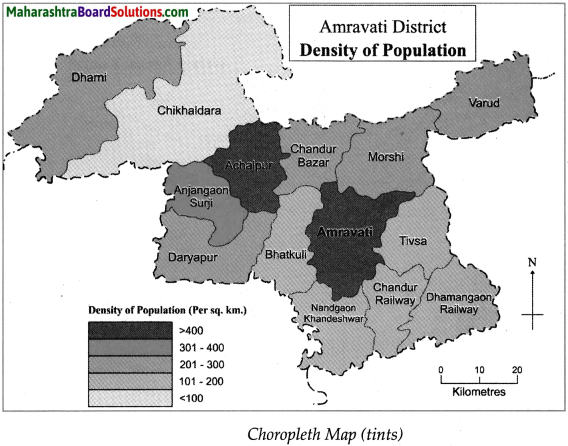
![]()

Question 1.
Name the talukas having population density between 301 and 400 persons per sq km.
Answer:
Anjangao Surji has population density between 301 and 400 persons per sq km
Question 2.
What is the density of the Amravati taluka?
Answer:
Amravati taluka has the population density of more than 400 persons per sq km
Question 3.
Name the talukas having population density less than 300 persons per sq km.
Answer:
Dharini, Chikaldhara, Daryapur, Chandur Bazar, Morshi, Varud, Tivsa, Dhamangaon Railway, Nandgaon Khandeshwar and Bhatkuli have population density less than 300 persons per sq km.
Question 4.
Which taluka has a population density of less than 100 persons per sq km?
Answer:
Chikaldhara has population density of less than 100 persons per sq km.
![]()
Question 5.
Which Talukas have a population density of more than 400 persons per sq km?
Answer:
Amravati and Achalpur have the population density of more than 400 persons per sq km.
Read the map given below and answer the Questions:

Question 1.
In which part of the district is the rainfall more?
Answer:
Rainfall is more in the Northern part of the district.
Question 2.
In which direction is the rainfall decreasing?
Answer:
Rainfall is decreasing towards the west
Question 3.
What is the lowest value of the rainfall in the district?
Answer:
The lowest value of the rainfall in the district is less than 800 mm.
Question 4.
What is the highest value of the rainfall in the district?
Answer:
The highest value of the rainfall in the district is more than 1300 mm.
![]()
Question 5.
What is the amount of rainfall in the central part of the district?
Answer:
The amount of rainfall in the central part of the district is 900 mm.
Read the map given below and answer the Questions:
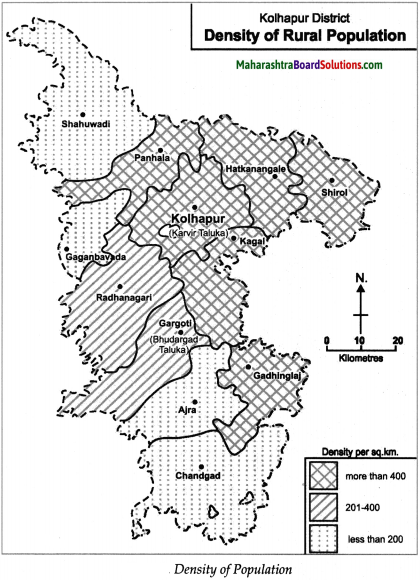
Question 1.
In which direction is the density of population decreasing?
Answer:
The density of population is decreasing towards the North and South direction.
Question 2.
Name the talukas with a population density less than 200.
Answer:
Shahuwadi, Gaganbavada, Ajra and Chandgad have a population density of less than 200.
Question 3.
Name the talukas having population density between 200 and 400.
Answer:
Radhanagri and Gargoti have population density between 200 and 400.
Question 4.
Name the talukas with a population density more than 400.
Answer:
Kolhapur, Panhala, Hatkanangale, Shirol, Gadhinglaj and Kagal have population density more than 400.
Question 5.
In which direction are the talukas having a higher density of population located in the district?
Answer:
The Eastern part of Kolhapur has a higher density of population.
![]()
Question 6
Which method has been used in the making of this map?
Answer:
Choropleth method is used in making this map.
Read the map given below and answer the Questions:
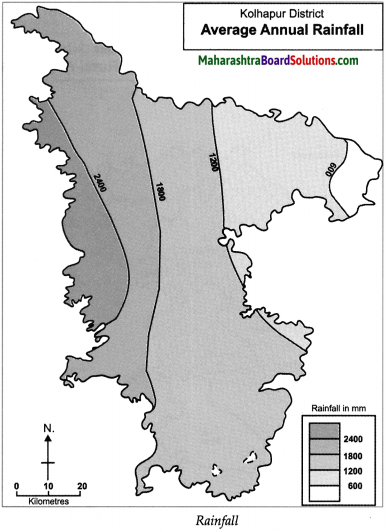
Question 1.
In which direction is the rainfall more in the district?
Answer:
The rainfall is more in the Western part of the district.
Question 2.
In which direction is the rainfall decreasing?
Answer:
The rainfall is decreasing towards the East.
Question 3.
Which class shows low rainfall category in the district?
Answer:
O to 600 mm class shows low rainfall category in the district.
Question 4.
Which class shows high rainfall category in the district?
Answer:
More than 2400 (2400 to 3000 mm) class shows high rainfall category in the district.
![]()
Question 5.
Which method has been used in making this map?
Answer:
The Isopleth method has been used in making this map
Study the population distribution map of Kolhapur district and answer the following questions:
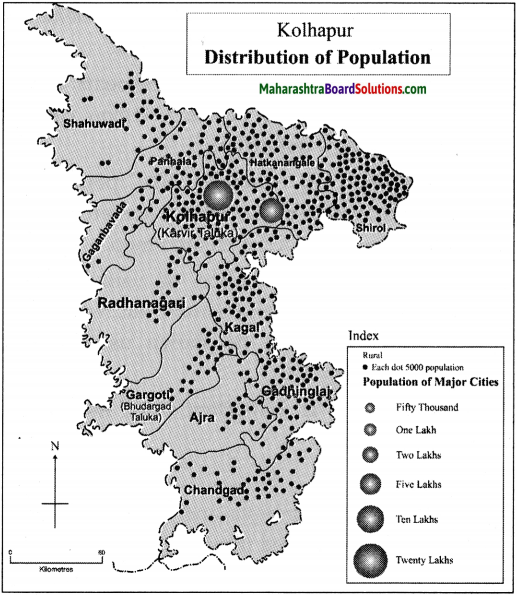
Question 1.
A field visit is an important study method in Geography.
Answer:
Right.
- Geographical concepts and elements can be directly experienced through field-visits.
- Field-visits are extremely useful for understanding the correlation between human beings and the environment.
Class 9 Geography Chapter 1 Distributional Maps Additional Important Questions and Answers
Complete the statements choosing the correct option:
Question 1.
The main aim of distributional maps is to show the location of the place and of variables.
(a) population
(b) statistics
(c) consumption
(d) distribution
Answer:
(d) distribution
Question 2.
Distributional maps are of types.
(a) two
(b) three
(c) four
(d) five
Answer:
(b) three
![]()
Question 3.
To draw distributional maps, we need data.
(a) statistical
(b) population
(c) colourful
(d) distance
Answer:
(a) statistical
Question 4.
The distribution of population is shown by method.
(a) dot
(b) choropleth
(c) isopleth
(d) isolines
Answer:
(a) dot
Question 5.
In maps, the data regarding various geographical variables are shown by shading or tints of various colours.
(a) dot
(b) choropleth,
(c) isopleth
(d) thematic
Answer:
(b) choropleth
Question 6.
When the distribution of a variable is discontinuous the map is used.
(a) isopleth
(b) physical
(c) choropleth
(d) dot
Answer:
(c) choropleth
![]()
Question 7.
In method, lines showing equal values are used.
(a) choropleth
(b) isopleth
(c) dot
(d) planar
Answer:
(b) isopleth
Question 8.
When the distribution of a variable is the isopleth method is used.
(a) continuous
(b) discontinuous
(c) sparse
(d) disjoint
Answer:
(a) continuous
Question 9.
While showing population distribution, urban population is shown by
(a) circles
(b) dots
(c) squares
(d) lines
Answer:
(a) circles
Question 10.
is an important study method in Geography.
(a) Maps
(b) Field visit
(c) Picnic
(d) farm visit
Answer:
(b) Field visit
Match the column.
Question 1.
| Group A | Group B |
| (1) Dot method | (a) distribution of temperature |
| (2) Choropleth method | (b) distribution of cotton crop |
| (3) Isopleth method | (c) density of population |
Answer:
(1 – b),
(2 – c),
(3 – a)
Question 2.
| Group A | Group A |
| (1) Dot method (2) Choropleth method (3) Isopleth method |
(a) variables are freely scattered (b) distribution of the variable is continuous (c) distribution of the variable is shown in sub administrative unit |
Answer:
(1 – a),
(2 – c),
(3 – b)
Answer in one sentence:
Question 1.
What are distributional maps?
Answer:
Maps that show the distribution of various geographical variables are called ‘distributional maps’.
Question 2.
What are thematic maps?
Ans,
Maps that are prepared with special themes are called ‘thematic maps’.
Question 3.
What is a dot-method map?
Answer:
A dot method map is a map type, that shows the distribution of a variable using dot symbols.
Question 4.
What is a choropleth method map?
Answer:
A choropleth method map is a map type, in which the distribution of a variable is shown by shades or tint of various colours.
Question 5.
When do we use the isopleth method for showing the distribution of a variable on a map?
Answer:
We use the isopleth method for showing the distribution of a variable on a map, when the distribution of the variable is continuous.
![]()
Question 6.
What is an isopleth method map?
Answer:
An isopleth method map, is a map type, that shows distribution of a variable with the help of lines showing equal values.
Question 7.
What is point related data?
Answer:
The statistical data of particular variables with respect to various places is called ‘point-related data’.
Question 8.
Which elements are generally studied in a geographical field visit?
Answer:
The various elements which can be studied during geographical field visits include physical landforms, river banks, dams, coastal areas, tourism sites, offices or museums related to geographical elements, villages, forest areas etc.
Question 9.
Mention the list of things to be carried while going on a geographical field visit?
Answer:
The various things which one should carry to a geographical field visit include notebook, specimen Questionnaire, pen pencil, scale, tape, compass, bag for collecting samples, maps, camera, etc.
Question 10.
What is field report?
Answer:
The report written on the basis of the information obtained from a field visit is known as field report.
Which method will you use for the following information:
Question 1.
The distribution of rainfall in the district of Nandurbar.
Answer:
Isopleth Method
![]()
Question 2.
Cotton crop distribution in Maharashtra.
Answer:
Dot method
Question 3.
Draw a map using the Dot Method:
Answer:
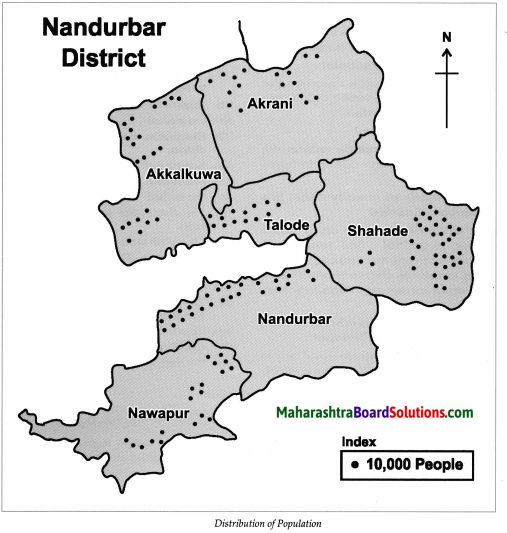
Explain:
Question 1.
Choropleth method
Answer:
- In the choropleth method various geographical variables are shown by shades or tints of various colours.
- While making choropleth maps, the data used for different variables is obtained through various processes such as measurement, surveying and so on.
- In this method, only one value is given to one sub – administrative unit in a region
- The smallest and the largest values of the given data of the variables are taken into consideration and after that 5-7 classes are made.

- Each class is assigned a tint of the same colour or black-and-white patterns. The shades or the patterns become darker with the increasing values of the given variable.
Question 2.
Preparations for field visit
Answer:
- Before going for a field-visit, decide the place and the purpose of the visit.
- The elements which will be observed in field visit should be decided.
- For a field visit, you should carry a notebook, specimen Questionnaire
- , pen, pencil, scale, tape, compass, a bag for collecting samples, maps, camera and any other item needed.
Question 3.
Selection of the study area
Answer:
- Geographical field-visit is organised for study of various elements, for example physical 1 landforms, river banks, dams, coastal areas, tourism sites, offices or museums related to ! geographical elements, villages or forest areas.
- Elements should be selected after studying : the local conditions and necessary permission letters should be obtained.
Question 4.
Report writing
Answer:
- A field-report should be written on the basis of information obtained after the visit is complete.
- Students should add photographs wherever necessary.
- The following points should be used to make a field report:
- Introduction
- Location map and Route Map
- Physiography1
- Climate
- Population
- Environmental problems and measures
- Land utilisation
- Conclusions
